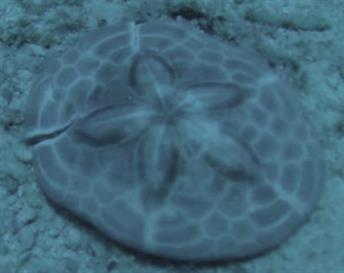



Clypeaster luetkeni
Size
To 10cm
Description:
Grey disc with mosaic, netlike patternof white lines. No marginal notches (image specimen has a split from damage). Pentagonal petal design on back.
Ecology
Rare to see on surface as usually buries itself below sand. Sand dollars possess a rigid skeleton known as a test. The test consists of calcium carbonate plates arranged in a fivefold radial pattern.
The petal-like pattern s consists of five paired rows of pores. The pores are perforations in the endoskeleton through which podia for gas exchange project from the body. The mouth of the sand dollar is located on the bottom of its body at the center of the petal-like pattern. Unlike other urchins, the bodies of sand dollars also display secondary front-to-back bilateral symmetry, with anus of at the back rather than at the top as in most urchins.
They move by using the tube feet on the spines located on their underside, feeding on small food particles in the sand. The particles land on the spines, and then are transported to the sand dollar's mouth by its tube feet, pedicellaria (pincers) and mucous-coated cilia.
Life Cycle
Seperate sexes (gonochoric). Fertilization is external. Brooding is common, eggs are held either on the peristome, around the periproct or deep into the concavities on the petaloids. Embryos develop into planktotrophic larvae (echinoplateus) and live for several months before they sink to the bottom using their tube feet to adhere on the ground where they metamorphose into young urchins.
To 10cm
Description:
Grey disc with mosaic, netlike patternof white lines. No marginal notches (image specimen has a split from damage). Pentagonal petal design on back.
Ecology
Rare to see on surface as usually buries itself below sand. Sand dollars possess a rigid skeleton known as a test. The test consists of calcium carbonate plates arranged in a fivefold radial pattern.
The petal-like pattern s consists of five paired rows of pores. The pores are perforations in the endoskeleton through which podia for gas exchange project from the body. The mouth of the sand dollar is located on the bottom of its body at the center of the petal-like pattern. Unlike other urchins, the bodies of sand dollars also display secondary front-to-back bilateral symmetry, with anus of at the back rather than at the top as in most urchins.
They move by using the tube feet on the spines located on their underside, feeding on small food particles in the sand. The particles land on the spines, and then are transported to the sand dollar's mouth by its tube feet, pedicellaria (pincers) and mucous-coated cilia.
Life Cycle
Seperate sexes (gonochoric). Fertilization is external. Brooding is common, eggs are held either on the peristome, around the periproct or deep into the concavities on the petaloids. Embryos develop into planktotrophic larvae (echinoplateus) and live for several months before they sink to the bottom using their tube feet to adhere on the ground where they metamorphose into young urchins.

| Ecological Descriptors | ||||
| Habitat | Size (cm) | Diet | Behaviour | Sex |
| Be, S | 10 | Det | I | F |
Mosaic Sand Dollar

265


